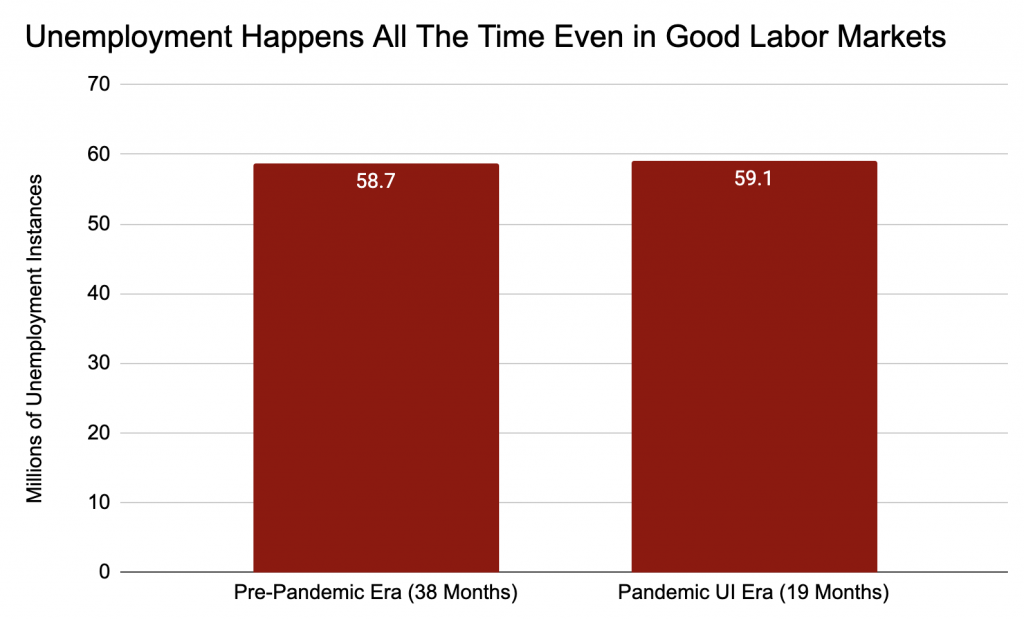Unemployment insurance (UI) is insurance for workers first and foremost. The overall unemployment level varies, but a constant stream of workers will always need UI when between jobs. Millions of workers cycle into unemployment as millions cycle into employment each month. Even in good years, over ten million people face unemployment spells.
For example, the pre-pandemic Trump era had some of the lowest unemployment rates seen in two decades. Yet, a similar number of unemployment events occurred then (58.7 million instances of unemployment between January 2017 and February 2020) as were experienced between the months that federal pandemic UI first passed and when pandemic benefits expired (59.1 million instances of unemployment between March 2020 and September 2021).

Unemployment benefits are supposed to keep workers financially stable during these typical labor market experiences. But the United States does not have adequate unemployment insurance. Benefits were bad before the federal pandemic programs and remain bad after those federal benefits expired. Permanent UI reforms are necessary, and political constraints may require selecting certain upgrades over others. Policymakers must prioritize well if the time comes.
Political battles from the past year risk distorting the order of priorities. States’ premature slashing of federal unemployment benefits has potentially led people to place disproportionate value on automatic stabilizers —metric-driven benefit enhancements when economic conditions are severe.
The rationale is sensible: rather than let political actors take matters into their own hands, let the numbers decide. Automatic stabilizers are indeed helpful if executed well. However, while the existing automated UI extensions — known as Extended Benefits (EB) — need improvements, they are not the utmost essential reform.
Benefit upgrades that are available to workers at all times take precedence. The main issue with UI is not a lack of responsiveness to recessions, it’s that benefits are chronically weak. Most unemployed workers do not receive UI, qualifying individuals receive too little support, and that support frequently lasts for too short a time. Individual workers can be financially devastated by unemployment regardless of the macroeconomic environment.
Preparing for bad legislative scenarios
Senator Bennet (D-CO) and Senator Wyden’s (D-OR) outlined UI reforms from 2021 are useful for presenting how to prioritize legislative provisions. The bill contains two sections directly related to UI benefits (a third section is about improving UI administration):
- “Title I: Modernization of Extended Benefits”
- “Title II: Modernization of Regular Unemployment”
The proposed EB expansions demonstrate a recognition that the economic environment influences the unemployment level and how straightforward it is to find a job. The time required to re-employ is shorter on average in strong labor markets (substantial demand for workers) but longer in weak labor markets (less demand for workers). As a result, a lineup of labor market scenarios could trigger additional weeks of UI for qualifying workers.
Regular unemployment benefits would also be standardized. Higher income replacement rates, a wider range of eligibility scenarios, and a requisite number of available benefit weeks would be mandated nationally.
Ideally, policymakers will walk and chew gum and make improvements across the board. Each portion of the Bennet-Wyden bill nets positive gains for workers if passed. If policymakers are forced to choose and do one section really well though, the modernization of regular UI benefits (Title II) is Priority I.
It is preferable to establish broader, constant benefits and rely on Congress for additional weeks of eligibility during recessions than to spend a rare reform opportunity on making the UI system function more like the Fed — adjusting rates according to the state of macroeconomic affairs — while insufficiently improving benefits in all economic climates.
The magnitude of job loss is too large in good job markets for general improvements to be bypassed for an emphasis on extensions in downturns. It does not make sense for unemployed workers to only get 40% of their income replaced in certain national contexts (pre- and post-pandemic), while getting a large majority of their income replaced in other national circumstances (the pandemic). Unemployment is unemployment no matter the status of the economy — job seekers need quality benefits to stay financially secure.
Improvements to Extended Benefits do warrant attention. The automatic enhancements are a key feature of the UI system, and may be the most politically viable avenue for implementing reforms. But it would be a missed opportunity for universal improvements to be considered secondary to conditional enhancements. Workers don’t need the rules of unemployment programs to change over time if benefits are consistently robust.

